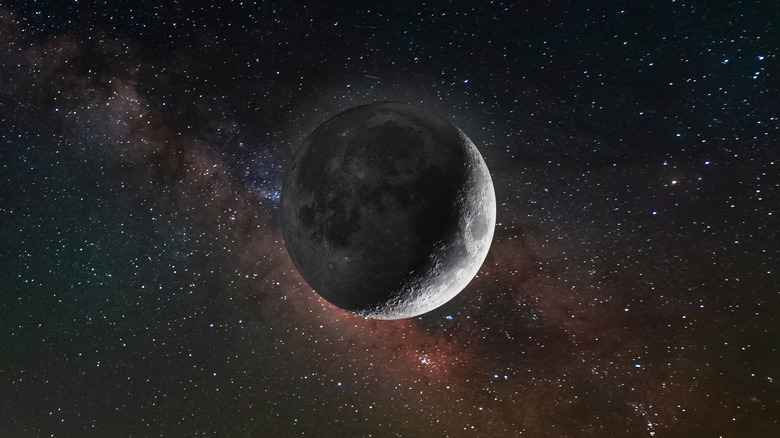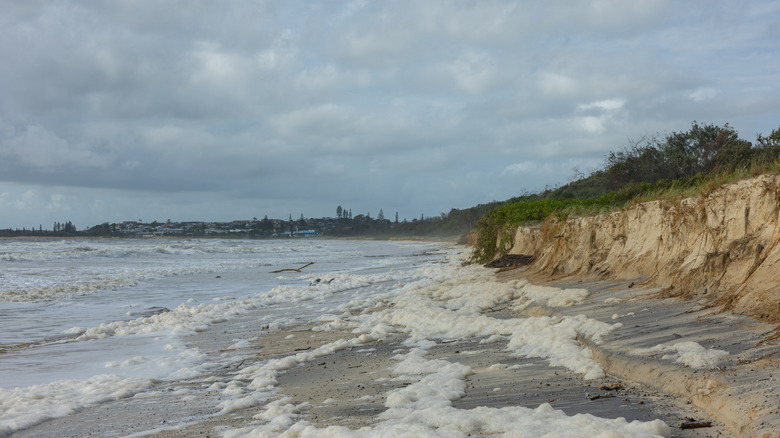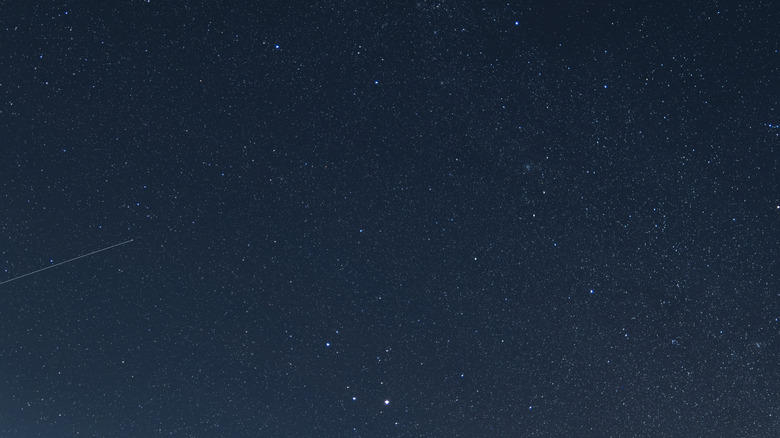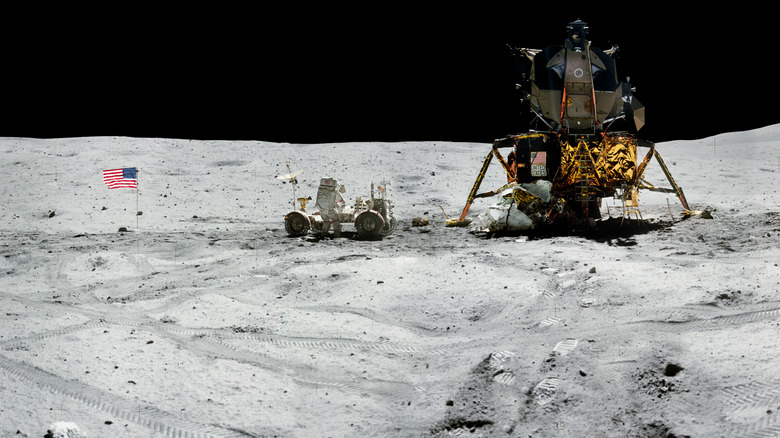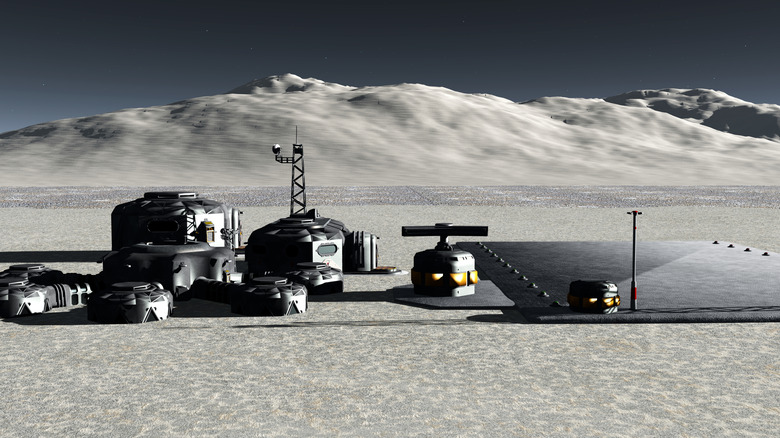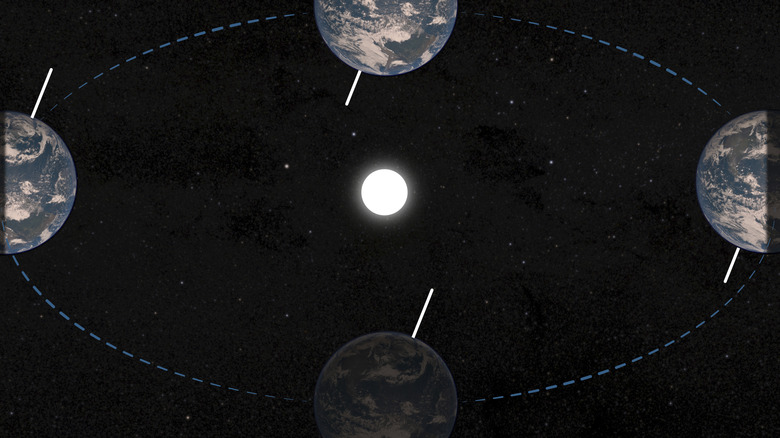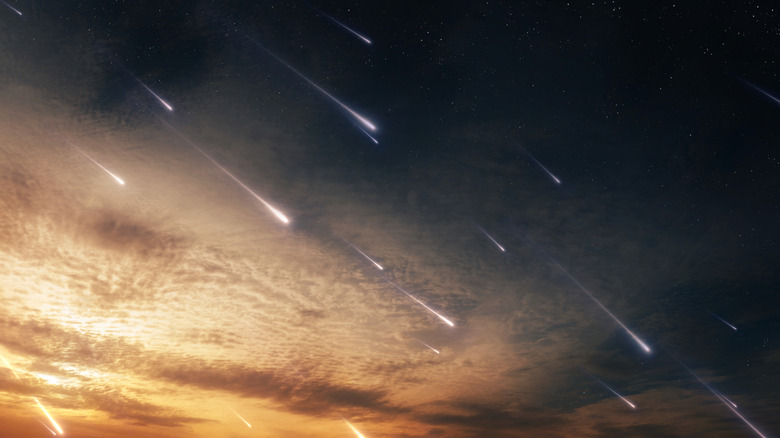What Would Happen If Earth Lost The Moon?
The gleaming moon hanging in our sky has been the subject of countless songs, poems, myths, and legends. But in reality, what would happen if the Earth suddenly lost the moon? Quite a few things, actually. The moon's influence on our planet is surprisingly powerful, both on human civilization and life as a whole. Therefore, the destruction of the moon would have catastrophic consequences for Earth.
Is that even possible, though? The moon is a massive celestial object. It might be smaller than Earth, but it is not going to be destroyed by a couple of bombs or asteroid impacts. Also, the commonly held belief that the moon will drift out of our planet's orbit is also not a real concern. While it is true that the moon is inching away from us, the rate of this drift is so slow that the sun would end before the moon reaches the end of its gravitational tether.
The only way for us to be rid of the moon is if it were shattered completely, as anything less would just have the fragments come together again due to gravity. But if the moon were to, say, collide with a rogue planet blitzing through our solar system, it would break apart explosively and leave our planet without its natural satellite. And things would never be the same again.
Marine ecosystems would collapse
The most visible impact of the loss of the moon would be on the tidal movements of the ocean. Because of the gravitational pull of the moon as it orbits our planet, the sea levels rise and fall periodically, giving us high tides and low tides. This might seem to be a minor effect, but in truth, it drives the circulation of ocean water, bringing in a steady supply of food to the shore, which coastal predators live off.
Then there are marine creatures that directly base their own life cycle on the lunar cycle. Just like how our very first calendars were based on the changing phases of the moon, many organisms have evolved to keep track of time through the lunar cycle. Coral polyps, for example, spawn in tandem right after a full moon. Then there are migratory birds like Barau's petrel that match their long journeys in sync with the moon, always arriving at their breeding grounds when the moon is full.
Without the beacon of moonlight these species would find their life cycles disrupted, pushing them into extinction. Marine creatures adapted to feed on coastal ecosystems would also suffer, as the lower tidal activity would halt the constant churning of the ocean that yields them sustenance in the form of dredged-up phytoplankton and molluscs.
Coastal erosion would cease
Coastal food chains aren't the only things affected by tides. The constant back and forth of the seawater is also what primarily drives coastal erosion. Much like how the winds erode the ground and the hills, carving them into their weathered shapes, the tides have shaped our coastlines, chipping away at the land over the millennia.
These forces add up over a long period of time, steadily shrinking the land available to us. The world's coastlines are at risk due to the double whammy of tidal erosion and rising sea level due to climate change, posing a grave threat to the future of coastal communities.
The disappearance of the moon would thus end up having a positive effect in this regard. Without the daily rise and fall of the tides, coastal erosion would nearly cease, bringing an end to the tug-of-war between the earth and the sea.
Temperature regulation of the seas would be thrown out of whack
The sun does not heat all parts of the planet equally. The equatorial belt receives more sunlight, while the temperate and polar zones receive far less, creating a temperature imbalance between the latitudes. And as is the case with any fluid, a temperature imbalance causes it to flow and establish an equilibrium. For the ocean, this takes the form of swift-running ocean currents, driven by the winds to carry hot or cold water from one part of the world to another.
But the ocean currents alone are not enough to sufficiently distribute this heat. Their area of influence is narrow, and most currents are close to the surface, leaving the depths untouched. That is where tidal currents come in. These currents create a constant cyclical motion of water mixing heat from warmer to cooler ocean areas, regulating the extremes by distributing it evenly.
In conjunction with the currents, tidal motion is responsible for the moderating influence of water bodies on coastal climates, making these geographies far more habitable. Without the moon and its tidal pull, the temperature differences would become more pronounced, harming not just the ecology but also human habitation.
The night sky would be clearer
There are billions of stars in the sky, but light "pollution" makes it impossible to see more than a handful of them, at least from a modern city. But if you go to a deserted stretch of land with no artificial illumination, things are different. Except for one major irritant — the moon. The moon is the brightest celestial object of the night sky, drowning out dim stars with its luminescence. This is why stargazers always pick moonless nights to observe the night sky.
With the moon out of the picture, that wouldn't be a concern anymore. Every night would be ideal for stargazing, making amateur astronomy much easier. On the flip side, there would be no observing the moon itself or any of its related phenomena.
Eclipses, for example, would cease to be, since both the lunar and solar eclipses occur due to the moon. In one case, the moon hides the sun (solar eclipse), while in the other, the Earth's shadow obscures the moon itself (lunar eclipse).
We would lose an important facet of human history and culture
Most of the effects we have discussed are tangible, observable things that visibly change how things work on the planet. But the moon is also a celestial symbol, venerated and romanticized throughout human history. What would the loss of the moon mean for human culture?
The moon has been worshipped as a goddess in many ancient civilizations, though few modern beliefs survive. There are darker myths as well that have turned into pop culture, like werewolves or fae. More practically, the moon served as our only reliable means of keeping track of time, like a celestial clock of sorts. This is where we get the concept of a month, roughly corresponding to one complete lunar cycle. Many early calendars were thus derived from the moon's cycle, marking major festivals on lunar milestones like full moons, in a tradition that continues even today.
And that's before we get into how the moon has been an enduring inspiration for art. So many songs, poems, and stories are penned to the moon, celebrating its beauty or pondering its mysteries. Early science fiction loved speculating on what we would find on its surface, led by Robert A. Heinlein, who wrote titles like "The Man Who Sold the Moon" and "The Moon is a Harsh Mistress." Without the moon, we would have to contend with the loss of a major cornerstone of human culture and imagination.
Uncovering Earth's past would become trickier
The cultural impact of the destruction of the moon would be severe, but the moon is not just a symbol for our civilization. It is an actual treasure trove of scientific information as well. But why is the moon so scientifically significant anyway? Isn't it just a giant lump of rock?
Yes and no. The moon isn't a dynamic, living place by any means, yet it is this very static nature that makes it so special. It is essentially a time capsule, still holding every scar and disturbance of its billions of years of history. Earth's moon may even be the reason why our planet's atmosphere was able to survive.
The problem is that we have barely scratched the surface of the moon, both literally and metaphorically. NASA plans to send a rover to the moon by 2027, and other countries like China have also planned their own moon missions, looking to uncover more of the mysteries concealed beneath the celestial body's surface. It would take centuries, if not millennia, for us to learn all that we can from our natural satellite, and if the moon were to disappear before that, this knowledge would forever remain out of our grasp.
We would lose a major foothold in space
Research isn't the only reason why we have always been interested in establishing a presence on the moon. It's also the most convenient location for basing any future space missions that seek to explore our solar system, or even beyond. This is because any craft taking off from our planet has to contend with our powerful gravitational well. An enormous amount of fuel must be burned off to simply get into space, severely limiting the amount of equipment a single craft can carry.
As a result, any long-term space exploration initiative requires a base outside the Earth's gravitational well, where the equipment can be stored, assembled, and launched easily without wasting fuel. And the moon is the ideal location for building a base using inflatable habitats, with its weaker gravity, proximity to our planet, and potential reserves of frozen water.
It is not just theoretical either. Multiple proposals have already come up to establish a permanent lunar base, from the ESA's moon village concept to China's plan of building an underground base on the moon. If the moon were to turn to dust before we can realize this vision, humanity's ambitions of reaching the stars would be set back severely.
Earth's axial tilt would become unstable
As the Earth revolves around the sun it spins on a tilted axis of about 23.4 degrees, creating the progression of the seasons. Summer is the part of the year when the hemisphere is tilted toward the sun, while winter is the period when it faces away, receiving less sunlight. This axial tilt is not a natural occurrence, but rather a remnant from Earth's ancient collision with another celestial body. This means that there is no innate force maintaining the axial tilt, leaving it free to vary constantly as Earth wobbles like a spinning top.
But this does not happen, and the reason is our moon. Its gravitational pull acts like a counterweight of sorts, stabilizing our planet's wobble, which only varies by a couple of degrees over a long period of time. Without the moon, our axial tilt would be influenced by every passing celestial body, including our neighbouring planets. We could find our axis becoming almost perpendicular to the orbit, abolishing seasons entirely. Or our planet could even flip over, giving us summers of endless daylight and winters of eternal night.
Neither of these scenarios would be conducive to life. Our ecology struggles to adapt even when the seasons get slightly out of sync; so a drastic transformation of the climate would be an extinction event. Even smaller variations in the axial tilt would change the length and behavior of the seasons' cycles.
The debris would rain down on Earth
The only way we could lose the moon is if it were destroyed completely, and the consequences of such an event would go beyond the mere fact of its absence. If the moon were to be shattered into tiny fragments, they wouldn't just disappear. Instead, Earth's gravitational pull would start reeling them in.
This is nothing new. Defunct satellites, space debris, and even broken chunks of asteroids are routinely captured by our planet's gravity and end up orbiting it. Over time, they lose their momentum and fall, burning up in the atmosphere. But the shattering of the moon would release more than just a few fragments, and unless they gained enough momentum to escape Earth's gravity, they would end up being captured as well. A dense debris cloud like this can make future rocket launches impossible, at least until they start raining down on the surface.
That is not necessarily bad. Plenty of asteroids hit the Earth without dealing any damage. Most of the lunar fragments would be small and would just burn up during atmospheric entry. But the breakup of an object as massive as the moon would create some really large chunks, and these would impact explosively. With enough of these impacts Earth would be devastated, both by the shockwaves and the constant heat released by every burning fragment. And depending on how many moon fragments end up in orbit around our planet, these impacts could continue for hundreds or even thousands of years.
